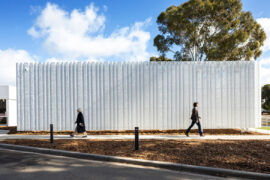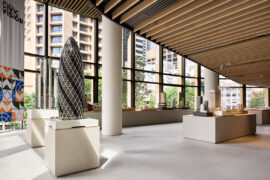Today we’re busting a few myths troubling the carpet industry and also telling you why they make for such great additions to your indoor spaces.
There has been a lot of scaremongering over the years where carpet appears to be the enemy when it comes to aggravating health conditions like allergies and asthma. This has been a significant concern for the carpet industry to address as well. But, are these concerns justified? Today, evidence and research will point to the many health and psychological benefits that carpet-covered spaces provide to their users. If anything, carpets have the ability to soothe the senses and positively impact our mental and physical health.
Contrary to claims many years ago that held carpet responsible for contributing to issues for allergy sufferers, in 2005, a German study commissioned by the DAAB (The German Allergy & Asthma Society) found that smooth flooring increased the risk of fine dust load in indoor spaces versus rooms with fitted (wall-to-wall) carpets. Rather, the latter was in fact responsible for significantly minimising the health risks posed, especially in asthma and allergy patients. In another study involving 4,634 school-going children in New Jersey, it was also observed that carpeting provided protection against allergies and asthma. Carpets in the bedrooms implied fewer leaves of absence from school and less asthma medication.
In yet another international survey by the European Community Respiratory Health Service Study involving 19,000 people from 18 countries, including Australia, New Zealand, India, and the United States of America, it was found that people with sensitivity to dust mites actually responded better when carpets were used in the room.
A common misconception is that carpets are a cause of allergy increase. However, because allergens are transmitted through the dust particles in the air, this dust, hair and ultra fine particulate matter will be easily stirred and blown up in the air with as little as a breeze wafting in through the window, or people walking in a room. This is then inhaled, causing discomfort and irritation. And this is where the myths need to be debunked: contrary to popular belief, the fibres in carpets are able to trap these allergens and dust particles to ensure they are not released in the air so easily, unlike with hard flooring, where the dust particulates are easily disturbed through any movement through the space. As with all flooring, a sensible maintenance program is essential and for carpets – particularly when using a HEPA-filter vacuum cleaner – trapped allergens and dust mites will be permanently removed. What this does is mitigate allergy or asthma attacks brought on by dust, and some carpets are far more effective than others in doing this.
Among other health benefits, the Carpet Institute of Australia Ltd finds that carpets also emit lower levels of volatile organic compounds (VOCs). They explain how carpets are made to pass through a finishing oven that removes most of the solvents and volatile chemicals, leaving the final product with low VOC content. As a result, the emissions are significantly lower as well, especially when compared to most other building materials present indoors. What’s more, carpets tend to absorb VOCs like formaldehyde. This goes on to have a ripple effect of health benefits that help users breathe easy while also improving indoor air quality.
As it turns out, slips and falls are among Australia’s largest and most expensive public health problems. That’s why carpets are particularly beneficial when it comes to maintaining safer surfaces in homes, educational and healthcare facilities. In fact, the Building Code of Australia has developed specific slip-resistance classifications for carpets, especially for stairs and surfaces of ramps and landings.
Carpets are also ideal for enhancing the thermal performance of indoor spaces and reducing reliance on air conditioning or heating systems. Plush carpet piles paired with dense underlays absorb and trap heat, keeping spaces warm in winter and cool in summer.
Carpets have also been shown to bring down stress levels. The feeling of softness and padded flooring underfoot has an immediate effect on the mental frame of mind. In a study that asked forty-two people to walk on wooden flooring and carpeting for 10 minutes each; it was observed that the latter induced lesser stress than its wooden counterpart. That carpets can help in reducing psychological stress suggests the need to address the value of carpeting in indoor spaces and improving its overall public perception.
Also, with properties like noise attenuation and sound-proofing, carpets are able to reduce stress from noise control, improve productivity and also impact patient health positively in aged care facilities.
So, have you considered investing in a culture that promotes wellness, indoors? For quality carpeting solutions that create non-toxic, breathable, and sustainable indoor environments, get in touch with The Gibbon Group. They may just have the answer you’re looking for, whether that’s the contemporary chic of Modulyss or classic durability of Tretford (pictured above). Find out more here.
INDESIGN is on instagram
Follow @indesignlive
A searchable and comprehensive guide for specifying leading products and their suppliers
Keep up to date with the latest and greatest from our industry BFF's!

Rising above the new Sydney Metro Gadigal Station on Pitt Street, Investa’s Parkline Place is redefining the office property aesthetic.

CDK Stone’s Natasha Stengos takes us through its Alexandria Selection Centre, where stone choice becomes a sensory experience – from curated spaces, crafted details and a colour-organised selection floor.

Inside Bangkok’s Siam Paragon Mall, L’Atelier by Dinding Design Office celebrates the artistry of independent watchmaking through a space defined by light, craft and meticulous detail.

Through expert architecture, EBD Architects has provided a human face to great design and created a project that enhances the lives of people and community.

The BLP Managing Director & Principal has been named recipient of the very first Australian Health Design Council (AHDC) Gold Medal Award.

In a landscape clouded by data and greenwash, Product Aware offers architects and designers a common language for sustainability. Embraced by suppliers – including Milliken – it is setting a new benchmark for trust and bringing clarity and accountability to material specification.
The internet never sleeps! Here's the stuff you might have missed

Civic Vision, a major exhibition showcasing the global work of Foster + Partners, has officially opened in Sydney.

Guests joined Cosentino for a behind-the-scenes look at The Block homes, discovering new materials and creative partnerships.